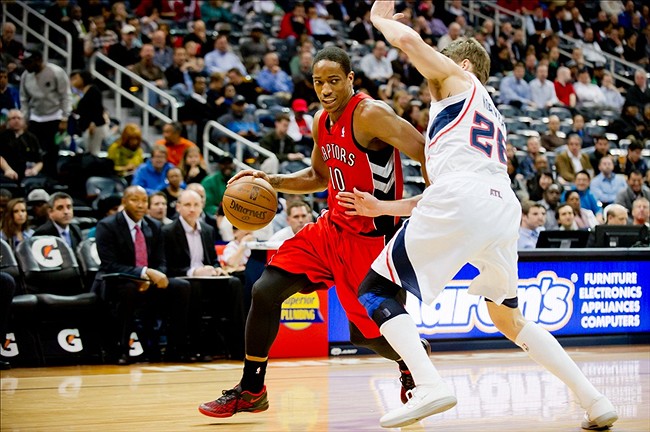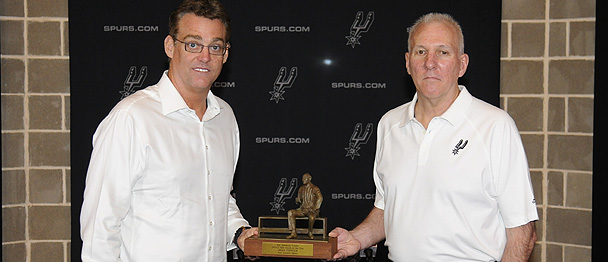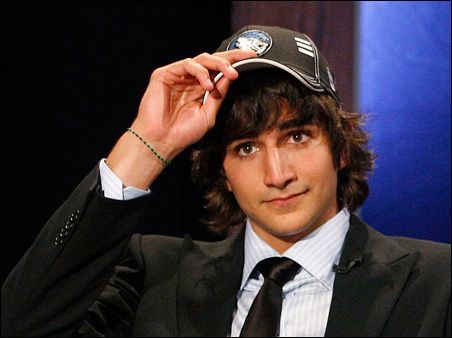This may come as a surprise but great shooting guards are becoming extinct. Consequently, anything resembling a good or average 2-guard is now somewhat overvalued. This begs the question: where does DeMar DeRozan fit in all of this?
Once upon a time, the Association was flooded with quality shooting guards. Indeed, the sheer rich amount of off-guards led many teams to build their franchises around them. Think of the Orlando Magic with Tracy McGrady, the Philadelphia 76ers with Allen Iverson or even the Toronto Raptors with Vince Carter.
But that is officially a thing of the past.
The NBA is now the home of three great 2-guards, maybe four if we stretch it: Kobe Bryant, Dwyane Wade, James Harden and Manu Ginobili (borderline selection).
The remaining guys that play the position are either one-dimensional or inconsistent players with potential. In truth, there’s nothing wrong with being a decent shooting guard, but a great one can take you places when flanked alongside a solid frontcourt.
This is where DeRozan’s potential comes in.
He is a talented and athletic player with a streaky jump shot. When lanes open up and he puts his head down in direction of the rim, good things tend to happen.
Mind you, the personnel coupled with the offensive schemes the Raptors use fail to consistently highlight his skills.
The Raptors are a bottom five 3-point shooting team. Because Toronto lacks shooters, it creates situations where the paint is often condensed by opposing defenses.
Consequently, DeRozan typically catches the ball on the wing and sees nothing but layers of defense. That partly explains why he spends a lot of time floating out on the perimeter.
Dwane Casey’s solution — a smart one — is to have his starting shooting guard catch the ball on the move. By receiving the ball already going towards the basket, it relieves him off the pressure of creating off the dribble and making decisions when swarmed.
The one problem with the strategy: opponents know it. Hence, they pack the paint, which in turn forces DeRozan to catch and shoot. Per Synergy Sports, the Raps’ 2-guard is converting 41.6 percent of his shots coming off screens.
For the sake of context, have a quick look at the conversion rate of other notable players at his position:
Player | FG% Off Screens |
Kobe Bryant | .449 |
Manu Ginobili | .435 |
Dwyane Wade | .385 |
James Harden | .344 |
DeRozan’s shooting percentage in this scenario is more than adequate in comparison to the league’s greats. The one caveat though: these four players rarely use off-ball screens for scores. In fact, for the most part, it’s the least used technique they use to generate shots per Synergy Sports.
In the case of DeRozan though, 16.2 percent of his field goal attempts stem from him coming off screens. That’s the second highest percentage of plays he uses to create shots.
Thus, several of his field goal attempts are being put up with defenders in his grill.
In other words, Toronto is misusing him.
Andrea Bargnani was supposed to help mitigate this issue. Camping him on the opposite side of the court would help stretch out the defense and remove one big man from the paint.
In addition, DeRozan could even curl off a Bargnani screen and when his defender would step up to thwart the guard, DeMar would be afforded with the possibility of dishing to Bargs for an open jumper.
Mind you, Il Mago’s lost shooting touch, coupled with his injury have certainly complicated matters for the offense.
Put it all together and DeMar DeRozan has taken the second most amount of midrange jumpers in the league this season per NBA.com’s advanced stats tool. For a player with his athleticism, that’s a startling revelation.
The best 2-guards in the league are exceptional pick-and-roll players. They break down defenders off the bounce for scores and also find open teammates on the move.
The Toronto highflyer is not yet a great ball-handler or passer, so putting him in those situations would not benefit him or the Raptors.
In the offseason, Toronto would be best served by having the 23-year old work on these facets. It would certainly give the offense a new dimension and make the off-guard a bigger threat next season.
In terms of Casey’s concepts, tweaking them might be in order. DeRozan spends a lot of time on the weak side of the court looking like a Blue Jays outfielder whenever the Raptors run a play for another player.
It might behoove Toronto to have him set picks or come off screens even on the opposite side of the action for the sake of keeping defenders occupied. Also, he might even get free by doing so.
With Rudy Gay now a member of the team, one can only wonder if Casey will overhaul his philosophy and play an up-tempo offense. Between the starting wing players, Kyle Lowry and Terrence Ross, it might just be the best route for the unit.
DeRozan is part of the team’s future, perhaps the offense should occasionally reflect that.
Statistical support provided by NBA.com.



